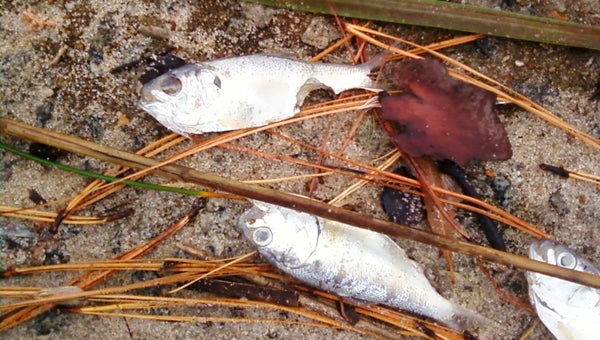Fall fish kill hits Pamlico
Published 6:49 pm Wednesday, October 2, 2013

PAMLICO-TAR RIVER FOUNDATION | CONTRIBUTED
SOMETHING FISHY: Juvenile menhaden are being attacked by a fungus that causes open sores and death. For the second year running, the Pamlico and Neuse rivers have seen deaths in the hundreds of thousands as the water and air temperatures cool.
The river is littered with dead and dying fish and it’s a phenomena expected to last for several more days, according to local authorities.
The first signs of the massive fish kill were seen Friday in Chocowinity Bay. Since, the river has turned up hundreds of thousands of juvenile menhaden that appear to be suffering from a fungus, said Heather Jacobs Deck, the Pamlico-Tar River Foundation riverkeeper.
“It’s from Runyon Creek down to the east side of Blounts Bay — it’s all the way across the river,” Deck said. “Let me tell you, there are thousands out there. … This is probably in the order of hundreds of thousands in the Pamlico.”
For the second year running, cooler weather and water temperatures have spurred fish kills. As with last year’s kill, both the Pamlico and the Neuse rivers have been hit at the same time.
Until the water samples are tested, the exact root cause is unknown, but Deck said it may be the same as last year’s: A. invadans.
“It’s sort of a typical issue: it’s fairly naturally occurring all over the world,” Deck explained. “This fungus does typically grow and show its ugly head this time of year as temperatures start to cool, as the water starts to cool.”
Deck warned that, depending on which way the wind blows, property owners on either side of the river should be prepared for the dead to arrive onshore, if they haven’t already, and some should consider swimming carefully before wading in.
“Until we really know what type of algae is out there, it could be better to limit or avoid contact with the water, especially if you have an open cut or wound—which we would actually recommend at any time of the year,” Deck said.
While the weather for the upcoming weekend is forecasted as warm and sunny, Deck also noted that potential swimmers should be on the lookout for other waterborne complications: jellyfish.
“The water is salty right now — there are plenty of jellies out there,” Deck said. “People should be careful if they’re out swimming.”
Though algal blooms are naturally occurring in waterbodies worldwide, Deck said man does contribute to the issue.
“Part of what causes these algal blooms is we’re pumping too many nutrients into the river,” she said, pointing to a wet spring and summer and plenty of runoff in the river. “We can always do better with (preventing) that.”




